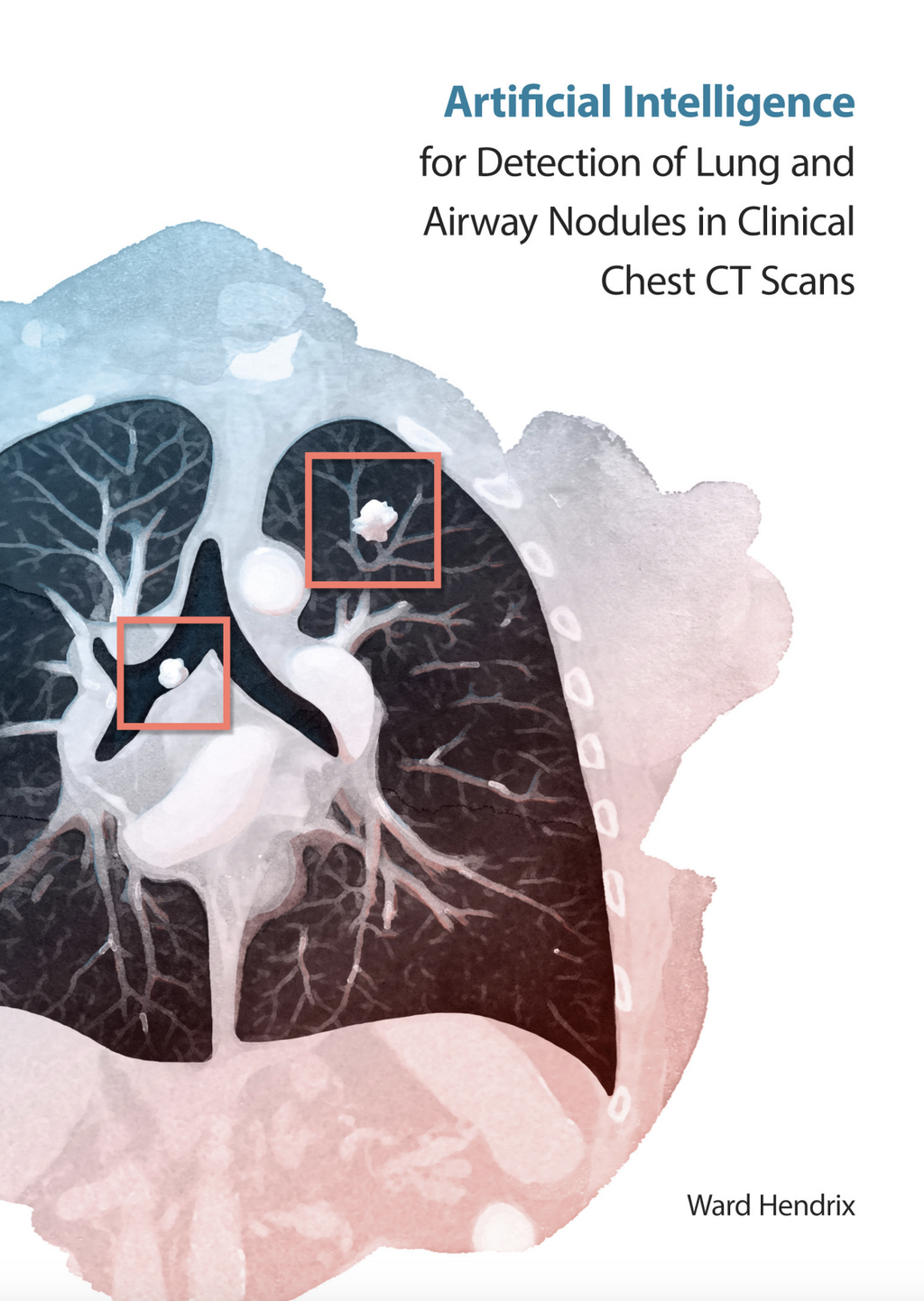Artificial Intelligence for Detection of Lung and Airway Nodules in Clinical Chest CT scans
W. Hendrix
- Promotor: B. van Ginneken and W. Prokop
- Copromotor: C. Jacobs and M. Rutten
- Graduation year: 2024
- Radboud University
Abstract
Lung cancer is one of the most common cancers and is worldwide the leading cause of cancer death. The five-year survival rate of lung cancer is only 22-25% due to the late diagnosis of the disease. Lung cancer remains asymptomatic for a long period of time, and even when symptoms develop, they largely overlap with those of chronic respiratory diseases. The prognosis for lung cancer patients substantially improves when the disease is diagnosed at an early stage when the tumor can still be surgically resected. For this reason, lung cancer screening programs have been proposed to identify tumors at an earlier stage. Early-stage lung cancers can be detected on chest radiographs and preferably chest computed tomography (CT) scans as small, round opacities, which are called pulmonary nodules. However, lung cancer screening has not yet been implemented in the Netherlands and many other European countries. Therefore, early-stage lung cancers are almost exclusively found on an incidental basis in routine clinical CT scans ordered for a large variety of medical purposes. The detection of pulmonary nodules in CT scans is a challenging task. Nodules can be as small as a few millimeters and require a thorough examination of a CT scan that is composed of hundreds of axial images. In daily clinical practice, this task is further complicated by the high workload of radiologists and the risk of bias, because nodules are not always the focus of an examination. The workload is expected to increase even more in the coming years due to the higher rate of CT examinations and lung cancer. This trend is mainly caused by the ageing population and enduring effects of historical tobacco use. Deep Learning-based Computer Aided Detection (DL-CAD) systems are promising tools to aid radiologists in nodule detection, but their performance has been understudied outside a lung cancer screening setting.
In Chapter 2, we studied the trends in the incidence of reported pulmonary nodules and early-stage lung cancer (stage I) in chest CT scans from two hospitals: the Radboud University Medical Center (Radboudumc) and the Jeroen Bosch Hospital (JBZ). For this analysis, we collected the radiology reports and metadata from 166,688 chest CT studies (74,803 patients) that took place between 2008 and 2019. A Natural Language Processing (NLP) algorithm was developed to automatically identify studies with any reported pulmonary nodule. We found that the number of patients who underwent a chest CT scan substantially increased over the past decade, as did the number of patients in whom a pulmonary nodule was identified. Both trends were accompanied by more stage I lung cancer diagnoses. These findings stress the importance of identifying and efficiently managing incidental pulmonary nodules in routine clinical practice.
In Chapter 3, we developed a DL-CAD system and assessed its performance for the detection of actionable benign nodules (requiring follow-up), small lung cancers (<= 3 cm), and pulmonary metastases in chest CT scans from Radboudumc (internal test set) and JBZ (external test set). A panel of five thoracic radiologists labeled all nodules, while two additional radiologists verified the nodule malignancy status and searched for any missed cancers using data from the national Netherlands Cancer Registry. We measured the sensitivity of the DL-CAD system at multiple false positive rates and compared the performance with the panel of radiologists. On the internal and external test set (100 scans each), the DL-CAD system reached a high detection sensitivity for all three nodule categories with an average of one false positive per scan. The system's sensitivity was found to be comparable to or higher than the radiologists, albeit with a higher false positive rate (average difference of 0.6). DL-CAD systems therefore show potential for aiding radiologists in detecting small lung cancers and pulmonary metastases for obtaining a timely diagnosis or monitoring disease progression.
In Chapter 4, we introduced a new DL-CAD system for the detection of benign and malignant airway nodules in chest CT scans. Airway cancers are a rare form of cancer that can be easily overlooked in chest CT scans, especially at an early stage. At Radboudumc, we retrospectively analyzed cancer diagnoses and radiology reports from all patients that received a thorax or thorax-abdomen CT scan in the period of 2004-2020. We collected 210 CT scans with and without airway nodules (n=160 and n=50) and confirmed the malignancy status of each nodule. A DL-CAD system was trained and evaluated with a ten-fold cross validation procedure. The system reached a detection rate of 77% for airway nodules, including 83% of the tumors, with an acceptable false positive rate. This study underscores the technological viability and potential clinical benefits of DL-CAD systems for assisting radiologists in detecting airway tumors in everyday practice.
In Chapter 5, we discussed the contributions of the thesis and directions for future research. To further improve DL-CAD systems and their adoption in routine clinical practice, future research should focus on the development of public datasets with routine clinical CT scans, detection of rare lung cancer appearances, training with confirmed tumors, and multicenter prospective validation through structured reporting and cloud technology.
